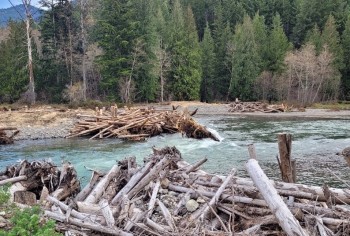Water, Air and Soil
The restoration of watersheds and forest health is one of our core management objectives. To achieve this goal we strategically invest in watershed improvement projects and conservation practices at the landscape and watershed scales. Past management activities have disrupted ecological processes, resulting in degraded fish habitat and water quality in localized areas across the Forest. In addition, climate change is projected to alter stream temperature, snowpack, and flow regimes of streams with potential consequences to physical watershed processes, infrastructure, Threatened and Endangered Salmon and Steelhead, and other native aquatic species.
Impacts to watershed health due to past management practices, as well as vulnerabilities to climate change, are actively addressed through the adoption and implementation of comprehensive aquatic conservation strategies that work to restore watershed processes in riparian areas to aid in the recovery of federally listed fish and to improve water quality.
Gifford Pinchot National Forest managers have identified priority watersheds for active restoration based on resource values, feasibility of improving watershed conditions through focused restoration projects, and strong ongoing partnerships and restoration projects.
- Yellowjacket and Camp Creek-Cispus River Subwatershed Restoration Action Plan (2022)
- Highlights:
- Cispus River-Yellowjacket Creek Restoration Project - Phase I is the first of a series of planned stream restoration projects in the Camp Creek-Cispus River and Yellowjacket Creek priority subwatersheds.
- Camp Creek Aquatic Organism Passage Upgrade will improve hydraulic capacity of the crossing to reduce potential failure.
- Highlights:
- Headwaters Wind River Subwatershed Restoration Action Plan (2021)
- Trout-Trapper Subwatershed Restoration Action Plan (2018)
The National Wild and Scenic Rivers System was created by Congress in 1968 (Public Law 90-542; 16 U.S.C. 1271 et seq.) to preserve certain rivers with outstanding natural, cultural, and recreational values in a free-flowing condition for the enjoyment of present and future generations. The abundant rain and snowfall in the western Cascades feed an extensive river system within the forest.
Many rivers are popular for recreation and contain remarkable features. Ensuring these features and the free-flowing character of popular rivers are maintained into the future, the Forest has recommended four rivers be added to the national Wild and Scenic Rivers System. They are: the Cispus River, the Lewis River, and the Clear Fork and Muddy Fork of the Cowlitz River. Thirteen additional rivers are being studied as potential Wild and Scenic Rivers.
The only river currently designated as a Wild and Scenic River within Gifford Pinchot National Forest is the White Salmon River. While the Gifford Pinchot National Forest manages the upper section of the White Salmon Wild and Scenic River designation, the Columbia River Gorge National Scenic Area manages the lower portion.
In accordance with Section 3(b) of the Wild and Scenic Rivers Act, the Forest Service is transmitting the final boundary of Upper White Salmon National Wild and Scenic River to Congress. The Upper White Salmon Wild and Scenic River boundary description is available for review by the public. Please contact Kyung Willis at (360) 891-5000 or Kyung.Willis@usda.gov for more information.
View the Upper White Salmon Wild and Scenic River Management Plan
(.pdf) - administered by Gifford Pinchot National Forest.
- View the Lower White Salmon River Wild and Scenic Management Plan (.pdf) - administered by the Columbia River Gorge National Scenic Area.
Learn more about Wild and Scenic Rivers at www.rivers.gov.
Additional Information:
Wilderness is the land that is rare, wild places where one can retreat from civilization, reconnect with the Earth, and find healing, meaning and significance.
There are seven designated Wilderness areas on the Forest. These areas are patrolled and managed by Wilderness rangers and managers. Rangers report on trail conditions, greet people on the trail, work to mitigate user impacts, answer questions, and enforce wilderness and climbing regulations. These skilled rangers also provide emergency help and communications in Wilderness areas. Recreation managers and crews work to clear trail and remove safety hazards in wilderness areas that forest visitors and wilderness rangers report.
Travel into wilderness areas at your own risk.
- Learn more about the unique aspects of designated Wilderness.




